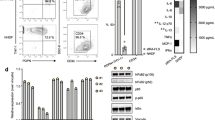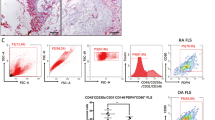Summary
Primary cultures of adherent rheumatoid synovial cells contain variable proportions of fibroblasts, macrophages, and dendritic cells, as judged by morphological appearance. Comparative studies using various enzymic and histochemical staining procedures showed the dendritic cells to lack many of the characteristic features of macrophages, e.g. the failure to express HLA-DR (Ia) antigen. The dendritic cells and fibroblasts had several similarities, but differed to some extent in their nonspecific esterase activity, phagocytic and proliferative potential. As the proportions of dendritic cells and fibroblasts varied in relation to specific culture conditions, we examined the possibility that these morphologies might represent different functional states rather than distinct cellular origins. Using subcultured synovial fibroblasts with a uniform bipolar appearance, we have shown that exposure to interleukin-1 or mast cell products resulted in a transformation to dendritic morphology. This change in cell shape was prevented by the presence of indomethacin, but was subsequently achieved by the addition of exogenous PGE2. Thus it appears that the latter is the factor that modulates the morphological change of fibroblastic to dendritic cells. This study has also demonstrated the complete and reversible interchange of fibroblast/dendritic morphology, thereby confirming that these different shapes are manifest by the same cell. The changes in phenotypic expression associated with the dendritic appearance include increased production of collagenase, prostaglandin E, and nonspecific esterase, as well as an apparent inability to exhibit phagocytosis and to proliferate in culture. We conclude from our in vitro studies that the phenotypic behaviour of the synovial fibroblast (or synoviocyte) is very variable and dependent to a large extent upon local stimuli, but the identity and hierarchy of such stimulating and suppressive factors in relation to cellular interactions requires further study.
Similar content being viewed by others
References
Dayer JM, Krane SM, Russell RGG, Robinson DR (1976) Production of collagenase and prostaglandins by isolated adherent synovial cells. Proc Natl Acad Sci USA 73:945–949
Woolley DE, Harris ED Jr, Mainardi CL, Brinckerhoff CE (1978) Collagenase immunolocalisation in cultures of rheumatoid synovial cells. Science 200:773–775
Woolley DE, Brinckerhoff CE, Mainardi CF, Vater CA, Evanson JM, Harris ED Jr (1979) Collagenase production by rheumatoid synovial cells: morphological and immunohistochemical studies of the dendritic cell. Ann Rheum Dis 38:262
Dayer JM, Goldring SR, Robinson DR, Krane SM (1980) Cell-cell interactions and collagenase production. In: Woolley DE, Evanson JM (eds) Collagenase in normal and pathological connective tissues. Wiley, New York, pp 83–104
Winchester RJ, Burmester GR (1981) Demonstration of Ia antigens on certain dendritic cells and on a novel elongate cell found in human synovial tissue. Scand J Immunol 14:439–444
Burmester GR, Dimitriu-Bona A, Waters SJ, Winchester RJ (1983) Identification of three major synovial lining cell populations by monoclonal antibodies directed to Ia antigens and antigens associated with monocytes/macrophages and fibroblasts. Scand J Immunol 17:69–82
Baker DG, Dayer JM, Roelke M, Schumacher HR, Krane SM (1983) Rheumatoid synovial cell morphologic changes induced by a mononuclear cell factor in culture. Arthritis Rheum 26:8–14
Bromley M, Woolley DE (1984) Histopathology of the rheumatoid lesion. Identification of cell types at sites of cartilage erosion. Arthritis Rheum 27:857–863
Woolley DE, Tetlow LC, Evanson JM (1980) Collagenase immunolocalisation studies of rheumatoid and malignant tissues. In: Woolley DE, Evanson JM (eds) Collagenase in normal and pathological connective tissues. Wiley, Chichester, pp 105–125
Steinman RM, Cohn ZA (1973) Identification of a novel cell type in peripheral lymphoid organs of mice. J Exp Med 139:380–397
Olah I, Rohlich P, Toro I (1968) A special type of cell in the medulla of the rat thymus. Acta Biol Acad Sci Hung 19:97–113
Veerman A (1974) On the interdigitating cells in the thymusdependent area of the rat spleen — a relation between the mononuclear phagocyte system and T-lymphocytes. Cell Tissue Res 148:247–257
Chen L, Adams J, Steinman RM (1978) Anatomy of germinal centers in mouse spleen with special reference to follicular dendritic cells. J Cell Biol 77:148–164
Thorbeck GJ, Silbergery-Sinakin I, Flotte TJ (1980) Langerhans cells as macrophages in skin and lymphoid organs. J Invest Dermatol 75:32–43
Van Voorhis WC, Hair LS, Steinman RM, Kaplan G (1982) Human dendritic cells. Enrichment and characterization from peripheral blood. J Exp Med 155:1172–1187
Van Voorhis WC, Witmer MD, Steinman RM (1983) The phenotype of dendritic cells and macrophages. Minisymposium presented by the American Association of Immunologists Federation proceedings, vol 42, no 14. Rockefeller University, New York, pp 3114–3118
Dayer JM, Russell RGG, Krane SM (1977) Collagenase production by rheumatoid synovial cells: stimulation by a human lymphocyte factor. Science 195:181–183
Dayer JM, Goldring SR, Robinson DR, Krane SM (1979) Effects of human mononuclear cell factor on cultured rheumatoid synovial cells. Interactions of prostaglandin E2 and cyclic adenosine 3',5'-monophosphate. Biochim Biophys Acta 586:87–105
Weissenfels M (1967) Method for acid phosphatase. In: Pearse AGE (ed) Histochemistry, 3rd edn. Little, Brown and Co, Boston, p 729
Gomori AL (1968) Method for alkaline phosphatase. In: Pearse AGE (ed) Histochemistry, 3rd edn. Little, Brown and Co, Boston, p 710
Yam LT, Li CY, Crosby WH (1971) Cytochemical identification of monocytes and granulocytes. Am J Clin Pathol 55:283–290
Li CY, Lam KW, Yam LT (1973) Method for α-napthyl-ASD chloracetate esterase. J Histochem Cytochem 21:1–12
Washstein D, Meisel J (1968) Lead method for adenosine triphosphate. In: Pearse AGE (ed) Histochemistry, 3rd edn. Little, Brown and Co, Boston, p 721
Graham RC, Karnovsky MJ (1966) Method for peroxidase staining. J Histochem Cytochem 14:291–302
Li CY, Lam KW, Yam LT (1973) Esterase in human leucocytes. Methods for aminocaproate esterase. J Histochem Cytochem 21:1–12
Lillie HG (1944) Oil red ‘O’ method for lipids. In: Pearse AGE (ed) Histochemistry, 3rd edn. Little, Brown and Co, Boston, p 697
Dingle JT, Fell HB (1975) Acridine orange method. ‘Lysosomes’, biology and pathology 2. North Holland/American Elsevier, New York, pp 609–612
Marshall AHE (1948) A method for the demonstration of reticuloendothelial cells in paraffin sections. J Pathol 60:515–517
Pearse AGE (1959) The periodic acid schiff's reaction. Carleton's histological technique, 4th edn. Drury and Wallington, Oxford, UK, pp 204–206
Oppenheimer-Marks N, Grinnell F (1981) Effects of plant lectins on the adhesive properties of baby hamster kidney cells. Eur J Cell Biol 23:286–294
Yoffe JR, Taylor DJ, Woolley DE (1984) Mast cell products stimulate collagenase and prostaglandin E production by cultures of adherent rheumatoid synovial cells. Biochem Biophys Res Commun 122:270–276
Hendler PL, Lavoic PE, Werb Z, Chan J, Seaman WE (1985) Human synovial dendritic cells. Direct observation of transition to fibroblasts. J Rheumatol 12:660–664
Amento EP, Bhan AK, McCullagh KG, Krane SM (1985) Influences of gamma interferon on synovial fibroblast like cells. Ia induction and inhibition of collagen synthesis. J Clin Invest 76:837–848
Dayer JM, Bread J, Chess L, Krane SM (1979) Participation of monocyte-macrophages and lymphocytes in the production of a factor that stimulates collagenase and prostaglandin release by rheumatoid synovial cells. J Clin Invest 64:1386–1392
Dayer JM, Russell RGG, Krane SM (1977) Collagenase production by rheumatoid synovial cells: stimulation by human lymphocyte factor. Science 195:181–183
Hammerman D, Stephens M, Barland P (1961) Comparative histology and metabolism of synovial tissue in normal and arthritic joints. In: Mills LC, Moyer JH (eds) Inflammation and diseases of connective tissue. Philadelphia, pp 158–168
Author information
Authors and Affiliations
Rights and permissions
About this article
Cite this article
Gadher, S.J., Woolley, D.E. Comparative studies of adherent rheumatoid synovial cells in primary culture: characterisation of the dendritic (Stellate) cell. Rheumatol Int 7, 13–22 (1987). https://doi.org/10.1007/BF00267337
Received:
Accepted:
Issue Date:
DOI: https://doi.org/10.1007/BF00267337




